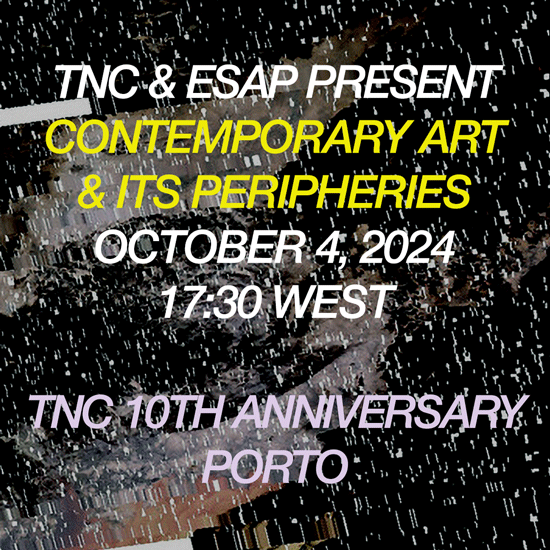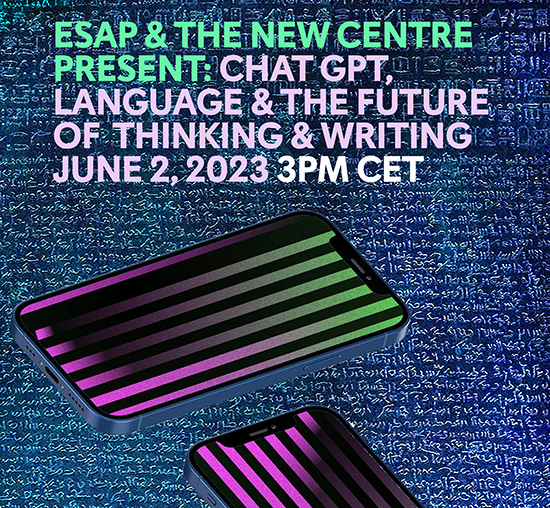&

"Contemporary Art & the Peripheries" is a Conference in celebration of the 10th Anniversary of The New Centre for Research & Practice, to be held in Porto, Portugal, on October 4th and organized in partnership with ESAP (Escola Superior Artística do Porto). The event will feature talks and roundtables with Eduarda Neves, Joel Blanco & Miguel Leiro, Jordan Strom, Mohammad Salemy, Né Barros, Reza Negarestani, and Shaun Dacey.
This informal Conference gathers art practitioners and theorists who inhabit a peripheral place within the global contemporary art world, featuring representatives from Richmond Art Gallery, Surrey Art Gallery, Mayrit Biennial, and also from the local context of Porto. Each guest will bring together theoretical models with case studies and practical experiences.
Focused on the claim that "another art world is possible" and exploring the direction of art in the 21st century, the guests depart from two provocative metaphors: Reza Negarestani's Human Centipede and Eduarda Neves' Minor Bestiary: Time and Labyrinth in Contemporary Art. These works offer a lens through which we can better understand contemporary art's often exploitative dynamics and attempt to use philosophy to renew and reshape the field.
In Human Centipede, Negarestani uses the grotesque image of a human chain stitched together, each body part feeding and being fed upon by the next, to depict the functioning of art discourse as it moves from one institution and curator to another. In this vision, artists, curators, critics, and collectors feed from each other, forming a parasitic relationship where creative output is consumed, processed, and regurgitated to sustain the field. In Minor Bestiary, Eduarda Neves presents a labyrinthine view of contemporary art, where the act of interpretation and meaning-making becomes an endless maze with no end. Artists, critics, and audiences wander through this intellectual labyrinth, navigating complex institutional structures that often obscure rather than illuminate the artworks themselves. Neves argues that contemporary art has become self-referential, prioritizing the process of interpretation and accumulating economic value over genuine engagement with the work.
Taking these texts as conversation starters, the Conference mixes the implications of the authors' ideas with field reports from the geographic peripheries of contemporary art to map out the possible future outcomes for the art world.
Beyond merely discussing these issues, the participants will be actively seeking solutions. Can art break free from the cycles of discursive consumption and reinterpretation? Can it escape the system that recycles creativity for market value? We're envisioning a new art world where genuine innovation and autonomy are possible, free from the parasitic and labyrinthine structures currently defining it. And we're asking you, the artists, curators, and critics, to play a crucial role in shaping this future.
EDUARDA NEVES: Minor Bestiary
Minor Bestiary contributes to the debate on a few issues in the scope of contemporary art: the first part is entitled “Time and the novelty of impotence”; it is followed by “The labyrinth or why art it has no beginning” and, finally, in the form of a post-scriptum, “Ice – at the end of the world, it is the universe that dreams”, a text that reflects on the relationship between art and tourism, an initiative developed in Portugal, 2022, (PORTUGAL ART ENCOUNTERS— PARTE Summit)* with Portuguese artists and galleries associated with a certain international curatorial contemporary art mainstream. Synthesizing this with figures from literature and philosophy allowed me to draft an ideological x-ray of our time, one that provided me with the dominant traits of contemporary art: subservience to the authority of sponsorship, the aestheticization of social demands, exposure and activism tailored for Instagram, a libidinal capitalism that sustains the economy of art, heterotopia reduced to ambition, prestige and power.
REZA NEGARESTANI: The Zombie Children of Time: A View from a Recursive Artworld
Centered on an unhappy and unconscious relation of the art world at large with its own undetermined collaboration, critique, and ultimately servitude to the ongoing computational, technical, and financial loops. This presentation focuses on a valorization of art as a set of algorithms the nature of which remains epistemologically, ethically, politically and financially opaque.
JORDAN STROM: Bursting Pipedreams in Candyland: Expo 86’s Counter Exhibitions
The mid-1980s was a transformative moment in the history of Canada. The country, as with North America more broadly, had been undergoing massive socio-economic changes in the aftermath of the oil crisis of the mid 1970s and recession of the early 1980s. A wave of conservative political realignments had swept the nation, poverty and homelessness had risen, economic restructuring had led to massive layoffs in the public and private sectors. Meanwhile, in the City of Vancouver, the planning of an array of mega-spectacles to coincide with the city’s centenary in 1986—including Vancouver’s world’s fair, known as Expo 86—was drastically reshaping the city. Artists were at the forefront of responding to these dramatic changes. In the period between 1984 and 1987, a wide array of new arts collectives, artist-led institutions, art initiatives and projects were launched to address these challenges. Yet, despite this surge of art and cultural expression, the world’s fair, and the larger year of cultural production has resulted in very little art historical attention in the intervening year. The art of the Expo 86 era—how this art responded directly and indirectly to the symbolic and real material and structural effects of Vancouver’s world’s fair—and this time of enormous transition is the subject of this paper. I will examine a number of specific art projects that lay on the periphery of the fair and challenged its official programming and spectacular logic.
SHAUN DACEY: Pacific crossings
The Richmond Art Gallery (RAG), located on the outskirts of Vancouver, Canada, is building connections and fostering partnerships with artist collectives, institutions, and artists across Asia through a series of ongoing residencies and dialogues. Rather than focusing solely on the major art centers of the West, RAG is refocused on engaging with emergent art communities in the Philippines, Vietnam, Japan, and other Pacific regions. I will discuss how Richmond, one of Canada's most culturally diverse cities and home to the largest proportion of Asian residents in North America, has influenced the gallery to reposition its programming and dialogue to reflect better the community it serves.
JOEL BLANCO & MIGUEL LEIRO: Report from Mayrit Biennale of Artchitecture & Design
Here is a glimpse of our experience as the curatorial director of the Mayrit Biennial, I will present the case study about how this Madrid-based event exemplifies the potential of art institutions positioned on the peripheries of the global art world and responding to other biennials around the world. The Mayrit Biennial merges design, architecture, and contemporary art, serving as a platform for emerging talent and fostering creative experimentation outside the central nodes of the traditional art market, deploying a decentralized model, encouraging genuine engagement with the work, fostering community, and creating opportunities for new forms of collaboration.
//////////////

Together with ESAP (Escola Superior de Arte do Porto), we hosted a roundtable titled "ChatGPT, Language and The Future of Thinking & Writing" on June 2nd, from 16:00-18:00 CET. You can watch it through this link.
ChatGPT and other developments in Large Language Models have taken the world by storm. Their profound and yet unformulated implications for thinking, reasoning and writing have sparked crucial debates on the transformation of human intellect and communication in our age. This roundtable explores the complex relationship between ChatGPT's emergence and the changes already underway in thinking and writing practices. This roundtable brings together: Elie Ayache, Joao Enxuto & Erica Love, AA Cavia, Joao Oliveira Duarte, Anna Longo, Rafael Moscardi, Reza Negatestani, Mohammad Salemy, and is Moderated by Romulo Moraes.
Featuring human-like text generation and comprehension capabilities, ChatGPT has found applications in a myriad of industries, from content creation to customer service. It also sparked a number of controversies for its usage on academic tasks such as writing, editing, and summarizing as well as uses in creative writing. As much as AI models have been instrumental in augmenting human intellect, they have also inherited the limitations and biases of the data they have been trained on. With that in mind, this roundtable asks: What are the limitations it reproduces? Are we on the brink of a new revolution in intellectual labor? What does ChatGPT say about our own capacity for reasoning in our predicament?
Below, you can find the abstracts from our participants:
Elie Ayache: ChatGPT cannot write, it can only predict text probabilistically and you know what I think of probability and prediction as opposed to writing. Definitely, some arguments from derivatives writing and trading should be brought to bear. Especially in relation with the future, whose awareness seems to be the necessary condition from AI to be capable of thought.
AA Cavia: AI as a research project has as its founding myth the notion that mimicry and intelligence are indistinguishable. What modes of artificial reason lie beyond the imitation game? I will argue for the centrality of the notion of a 'world model' in accounts of sapience.
João Oliveira Duarte: Our aim will be to address ChatGPT as a bodiless language from above as a particular example of Borges’s library: a place in which sense and nonsense, gibberish and meaningful sense, cannot be distinguished.
Joao Enxuto & Erica Love: We will discuss the uses and effects of deploying descriptors such as “dreaming” and “hallucinating” to generative AI and how these allusions to transcendental states confer (humanistic) artistic agency to computational processes.
Anna Longo: Based on statistical methods, chat GPT confirms opinions, perspectives, and knowledge that we have already rather than improving and differentiating them. Entailed by the strategy of the current industry for information production and consumption, it favorises the latter while reducing the space for actual "creativity" and dissent.
Rafael Moscardi: From the Jacquard Loom to the thermodynamic engine, from the computer to the database and now with ChatGPT and other LLMs, paradigmatic “machines” bring the demystification of a task and change the form and function of labor as such. Can we forecast where these developments are heading after the release of ChatGPT?
Reza Negarestani: ChatGPT is a logical continuation but also an exacerbation of the so-called arsenals of democracy. The focus will be on how ChatGPT can be seen via the emerging doctrine of weapon open system architectures where potentials for weaponization are developed in accordance with adversarial dynamics and threats which do not yet exist.
Mohammad Salemy: ChatGPT did not change the nature of thinking and writing, thinking and writing had already changed and this is precisely why ChatGPT emerged.
To see The New Centre Refund Policy CLICK HERE.